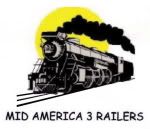I picked up my H7 and managed to get it in the house and up to the train room without going through customs and a congressional hearing about budget from the other person living here. Pictures below.
The good: it arrived in perfect shape. Everything works and works very well. I run conventionally with a ZW-L and that combination is superb: this will match or beat any other loco I have in slow speed smoothness - about 7 - 8 scale mph will pulling adequately and smoothly around curves, etc. Great sound - what I've come to expect from Legacy lately. Above average whistle in my opinion - very good "big loco" whistle sound. Nicely detailed cab. And fantastic looks. Lots of great details. I LOVE added-on equipment like pipes and pumps and who-knows what and this has it in spades and spades. Fantastic. The loco, set up, measures 30" from end of coupler to end of coupler (Vision Challenger and Legacy Yellowstone are both 32, Legacy Allegheny 31.75, The Legacy mallet considerable smaller. It wears its length well: looks fantastic when moving!!! Smoke works very well (at least for the twenty seconds before I turned it off).
The Bad: front boiler stick out, which I expected but which is, well, ridiculous to look at and annoying frankly. But this is a scale articulated loco - to be expected. See the photo: the inside edge of the boiler front is between the middle and outer rails on a 72" curve.
Worse that bad - nearly unacceptable. This is the most difficult locomotive I have, or have ever seen, to set up on the track. Frnakly, I was close to putting it back in the box. It took half an hour and many tries before I got it to sit straight so it would go around 72" curves. I set up up on a straight section or track - that might be a mistake, might be better to set it up on a curve. Anyway, it looked to be on the rails right, with every set of wheels with its flanges down and inside, etc, andit seemed true and level, but it de-railed (the rear flanged set of drivers on the front set flipped out over the outer rail) going around curves, particularly when going backwards. I eventually got it to work but it did the same thing again when I took it up to turn over and flipped the smoke switch and then return it to the rails and got it down, again, looking like it was on the rails correctly, even in close examination.
to get it to work each time, I havd to lift the front of the loco untilthe front set of drivers and wheels is hanging free of the track, and then "wobble" the front driver set back and forth to the maximum extent possible to sort of free it in its back and forth movement - I can't explain better . . . . Each time, it was at first catching on something the preventing it turning all the way into a left and turn, and when I pulled the driver set down and wobbled it back and forth that got it to swing free - I could feel it. Only then would go around curves well enough. (I repeated this whole thing two more times - taking it off, putting it back, and it did it each time. Apparently, I have to do this whenever I set up mine.
But once set up right, it did chug nobly and wonderfully around my big loop, 140 feet around all 72" and 84" curves with a couple of 72" switchbacks, but no switches, and four places where the track angles up or down slightly into or out of slopes, maximum of 2.5%. It looked great doing so. It sounded great.
And then, as planned, it went on the shelf. I bought this knowing it would have massive boiler stick-out, making it just too big to run all the time, but I wanted an H7 and now have one. I'll probably run it once and year, and hopefully remember about how to set it up - just in case, though, I wrote myself a note and taped it to the bottom of the loco.





